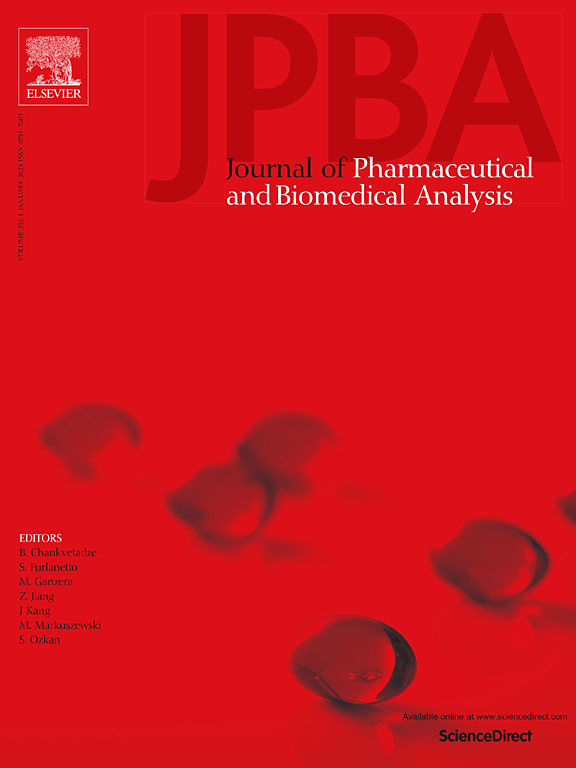Monolithic and hierarchically porous biochar/cellulose aerogel as adsorbent for microextraction in packed syringe towards trace sulfonamides in water samples prior to UPLC-MS/MS
IF 3.1
3区 医学
Q2 CHEMISTRY, ANALYTICAL
Journal of pharmaceutical and biomedical analysis
Pub Date : 2025-01-29
DOI:10.1016/j.jpba.2025.116714
引用次数: 0
Abstract
In this study, biochars with desirable adsorption capacity were prepared by calcination of herbal medicine residue, and the obtained biochars were loaded on cellulose aerogel through a green synthesis method. The monolithic biochar/cellulose aerogel hybrid was packed in the syringe and used as adsorbent for microextraction in packed syringe (MEPS). After introducing cellulose aerogel as the support, the loss of powdered biochars was avoided, and the entire extraction process can be achieved through simple operation of filtration due to the macroporous structure of cellulose aerogel. Coupled with UPLC-MS/MS, the established method was successfully applied to determine trace level of sulfonamides (SAs) in water samples. Extraction parameters such as pH of sample solution, adsorbent type, sample volume, elution solvent type and elution solvent volume were studied. Under the optimized parameters (pH of sample solution:7, adsorbent type: biochar/cellulose aerogel, sample volume: 20 mL, elution solvent: 0.3 mL methanol, the number of aspiration and dispense of sample solution, washing solvent and elution solvent: 3), desirable linearity correlation coefficient (r) in the range of 0.9951–0.9972 was achieved. The limit of detection varied from 0.00407 to 0.0104 ng/mL, and recovery ranging from 65.3 % to 102.4 % was obtained. The proposed method was demonstrated to be sensitive, accurate and easily operative, providing a convenient protocol for sample pretreatment.
求助全文
约1分钟内获得全文
求助全文
来源期刊
CiteScore
6.70
自引率
5.90%
发文量
588
审稿时长
37 days
期刊介绍:
This journal is an international medium directed towards the needs of academic, clinical, government and industrial analysis by publishing original research reports and critical reviews on pharmaceutical and biomedical analysis. It covers the interdisciplinary aspects of analysis in the pharmaceutical, biomedical and clinical sciences, including developments in analytical methodology, instrumentation, computation and interpretation. Submissions on novel applications focusing on drug purity and stability studies, pharmacokinetics, therapeutic monitoring, metabolic profiling; drug-related aspects of analytical biochemistry and forensic toxicology; quality assurance in the pharmaceutical industry are also welcome.
Studies from areas of well established and poorly selective methods, such as UV-VIS spectrophotometry (including derivative and multi-wavelength measurements), basic electroanalytical (potentiometric, polarographic and voltammetric) methods, fluorimetry, flow-injection analysis, etc. are accepted for publication in exceptional cases only, if a unique and substantial advantage over presently known systems is demonstrated. The same applies to the assay of simple drug formulations by any kind of methods and the determination of drugs in biological samples based merely on spiked samples. Drug purity/stability studies should contain information on the structure elucidation of the impurities/degradants.
文献相关原料
公司名称
产品信息
阿拉丁
N, N′-methylenebisacrylamide (MBA)
阿拉丁
Sulfamethizole (SMT)
阿拉丁
Sulfamethoxazole (SMX)
阿拉丁
Sulfapyridine (SPD)
阿拉丁
Sulfadimethoxine (SDMX)

 求助内容:
求助内容: 应助结果提醒方式:
应助结果提醒方式:


